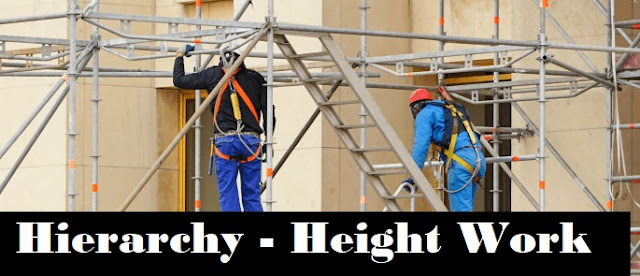Hierarchy of Preventative & Protective
Measures - Work At Height
Construction Site Electrical Safety
Before undertaking any work at
height, it is important to consider the work to be performed, taking account of
any foreseeable hazards arising from that work and establish control measures
to be implemented for the safe execution. It is essential that a competent
person carries out a suitable risk assessment and prepares the method statement
for the work at height. Planning for work at height must consider the hierarchy
of preventative and protective measures that are central to the Work at Height.
I. Avoiding the work at height - There
are few options available to the scaffolding industry which enable the task to
be executed without working at height e.g. fixing guardrails to precast stair
sections at ground level before craning them into place, thus avoiding the need
for the scaffolder to work at height. However, there is greater opportunity to
eliminate the need to work at height at the design and planning stages of a
project by designers and principal contractors e.g. the preassembling of
guardrails to steel beams prior to being installed by the steel erectors will
eliminate the need for scaffolders to install them at height. If avoiding work
at height is not possible then you must consider the next stage of the
hierarchy – prevent falls
II. Prevent the falls - Scaffolding
team should consider measures that create a safe zone by preventing falls from
height, such as providing adequate work platforms with suitable guardrails or
other collective measures, before resorting to personal fall protection
equipment (i.e. harnesses). Scaffolders are not permitted to work at height
while being exposed to a risk of a fall, without taking appropriate actions to
prevent or protect against a fall from height.
III. Mitigate the distance and
consequences of a fall Whatever methods of work are chosen, if it is not
reasonably practicable to prevent a fall, then both the distance and
consequences of a potential fall must be minimised. For example, if a fall
arrest harness is used with a fixed length lanyard then it should be attached
to a suitable anchor point as high above the working platform as practicable,
then should a fall occur the distance would be minimal compared with an
attachment at foot level. Ensure there is no materials stored in the working
area as this will create additional hazard to the working team.
IV. Collective over personal
protection equipment’s - At all stages
in the Working at height hierarchy, scaffolding working team must consider
collective protection over personal protection equipment’s. This means using
measures that protect everyone working at height at all times when in place,
such as guardrails or safety nets before specifying personal fall arrest
equipment that is reliant on being attached.





No comments:
Post a Comment